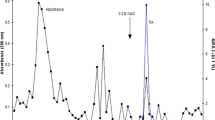Abstract
Enzymes are important tools for various applications. We have studied structural transitions and functional stability of a Kunitz trypsin inhibitor from Chickpea (CaTI2), a potent insect gut-protease inhibitor, under different stress conditions like non-neutral pH, elevated temperature and co-solvent concentrations. CaTI2 was cloned and expressed in an eukaryotic system P. pastoris and was investigated for conformational transitions using circular dichroism spectroscopy, differential scanning fluorimetry and activity assay. Native CaTI2 has a sheet dominant structure with 40% β sheets and possess a single tryptophan residue situated in the hydrophobic core of the enzyme. The recombinant inhibitor maintained its maximum activity under alkaline pH with its secondary structure intact between pH 6–10. CaTI2 was observed to be thermally stable up to 55 °C with a Tm of 61.3 °C above which the protein unfolds. On treating with chemical denaturant (urea), the CaTI2 lost its inhibitory potential and native conformation beyond 2 M urea concentration. Moreover, the protein unfolded at lower temperatures as the concentration of denaturant increased, suggesting more complex structural changes. Further, the stability of the inhibitor was found to be directly proportional to the solvent polarity. The data, herein offers significant information of inhibitor stability and activity which could be exploited for its further development into an effective pesticide.
Graphic Abstract




Similar content being viewed by others
Abbreviations
- BApNA:
-
Nα-Benzoyl-L-arginine para-nitroanilide
- BPT:
-
Bovine pancreatic trypsin
- CaTI2:
-
Cicer arietinum L Trypsin inhibitor 2
- CD:
-
Circular dichroism
- DSF:
-
Differential scanning fluorimetry
- KTI:
-
Kunitz type inhibitor
- PI:
-
Protease inhibitor
- STI:
-
Soybean trypsin inhibitor
References
Angkawinitwong U, Sharma G, Khaw PT et al (2015) Solid-state Protein Formulations Ther Deliv 6:59–82
Bendre AD, Ramasamy S, Suresh CG (2018) Analysis of Kunitz inhibitors from plants for comprehensive structural and functional insights. Int J Biol Macromol. https://doi.org/10.1016/j.ijbiomac.2018.02.148
Bendre AD, Ramasamy S, Suresh CG (2017) Chickpea Kunitz inhibitor: a mechanistic basis for trypsin inhibition. Acta Crystallogr Sect A Found Adv 73:C271–C271
Bendre AD, Suresh CG, Shanmugam D, Ramasamy S (2018) Structural insights into the unique inhibitory mechanism of Kunitz type trypsin inhibitor from Cicer arietinum L. J Biomol Struct Dyn. https://doi.org/10.1080/07391102.2018.1494633
Doukyu N, Ogino H, Ishikawa H et al (2007) Stabilities and Conformational Transitions of Various Proteases in the Presence of an Organic Solvent. Biotechnol Prog 23:155–161
Kalita J, Shukla R, Tripathi T (2019) Structural basis of urea-induced unfolding of Fasciola gigantica glutathione S-transferase. J Cell Physiol 234:4491–4503
Kamatari YO, Akasaka K, Konno T, Kataoka M (1998) The methanol-induced transition and the expanded helical conformation in hen lysozyme. Protein Sci 7:681–688
Kennedy AR (2011) Anticarcinogenic Activity of Protease Inhibitors Overview. Protease Inhib. as Cancer Chemopreventive Agents 9–64
Magnusson AO, Szekrenyi A, Joosten H-J et al (2019) nanoDSF as screening tool for enzyme libraries and biotechnology development. FEBS J 286:184–204
Nair M, Sandhu SS (2013) A Kunitz trypsin inhibitor from chickpea (<i>Cicer arietinum</i> L.) that exerts an antimicrobial effect on Fusarium oxysporum f.sp. ciceris. Agric Sci 04:585–594
Nair M, Sandhu SS, Babbar A (2013) Purification of trypsin inhibitor from seeds of Cicer arietinum (L.) and its insecticidal potential against Helicoverpa armigera (Hübner). Theor Exp Plant Physiol 25:137–148
Otzen DE (2002) Protein unfolding in detergents: Effect of micelle structure, ionic strength, pH, and temperature. Biophys J 83:2219–2230
Perutz MF (1978) Electrostatic effects in proteins. Science 80(201):1187–1191
Provencher SW, Glöckner J (1981) Estimation of Globular Protein Secondary Structure from Circular Dichroism. Biochemistry 20:33–37
Ranjekar PK, Patankar AG, Gupta VS et al (2002) Diversity in inhibitors of trypsin and Helicoverpa armigera gut proteinases in chickpea (Cicer arietinum) and its wild relatives. Theor Appl Genet 99:719–726
Salvi G, De Los RP, Vendruscolo M (2005) Effective interactions between chaotropic agents and proteins. Proteins Struct Funct Genet 61:492–499
Singh S, Singh A, Kumar S et al (2020) Protease inhibitors: recent advancement in its usage as a potential biocontrol agent for insect pest management. Insect Sci 27:186–201
Sreerama N, Woody RW (2000) Estimation of protein secondary structure from circular dichroism spectra: comparison of CONTIN, SELCON, and CDSSTR methods with an expanded reference set. Anal Biochem 287:252–260
Zhou J, Li C, Chen A et al (2020) Structural and functional relationship of Cassia obtusifolia trypsin inhibitor to understand its digestive resistance against Pieris rapae. Int J Biol Macromol 148:908–920
Acknowledgements
ADB and ES thank University Grant Commission, India for Research Fellowship. SKR thanks Department of Science and Technology, India for Ramanujan Fellowship. Additional thanks to Dr. Sivaramaiah Nallapeta and Dr. Saji Menon (NanoTemper Technologies, India) for providing DSF facilities. Authors thank Dr. C. G. Suresh, Dr. Dhanasekaran Shanmugam and Ms. Sanskruthi Agarwal for valuable suggestions.
Author information
Authors and Affiliations
Contributions
All experiments were performed by ADB and ES and were designed and monitored by SKR. All authors have approved the final article and submission.
Corresponding author
Ethics declarations
Conflict of interest
The authors declare that they have no conflict of interest.
Additional information
Publisher's Note
Springer Nature remains neutral with regard to jurisdictional claims in published maps and institutional affiliations.
Electronic supplementary material
Below is the link to the electronic supplementary material.
Rights and permissions
About this article
Cite this article
Bendre, A.D., Shukla, E. & Ramasamy, S. Functional Stability and Structural Transitions of a Kunitz trypsin Inhibitor from Chickpea (CaTI2). Protein J 39, 350–357 (2020). https://doi.org/10.1007/s10930-020-09911-2
Published:
Issue Date:
DOI: https://doi.org/10.1007/s10930-020-09911-2




